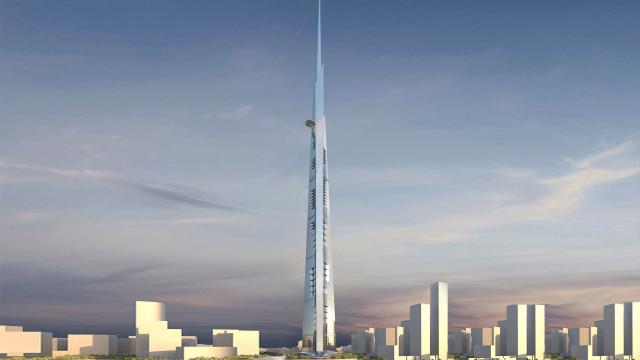Slowly but surely, the kilometre-high Kingdom Tower is coming to life. This week construction is set to move above ground after the tricky foundation stage is completed. Part of $US20 billion development dubbed Kingdom City, the tower will be at least 173m taller than the Burj Khalifa in Dubai.
There are plenty of technical challenges involved with building a one-kilometer-high tower, including (but in no way limited to!) lackluster elevator tech and the sheer weight of a tower this tall.
Earlier this year, a crucial step towards building the next tallest building on Earth kicked off with engineers devising a method how to pump wet concrete more than half a mile into the sky.
The developers engaged outside consultant — Advanced Construction Technology Services — to test logistics surrounding the materials needed to build the tower: half a million cubic meters of concrete and around 80,000 tons of steel.
The tower’s foundation is 60 metres deep — and it has to withstand the salt water of the nearby ocean. One of the major things ACTS tested was the strength of different high-performance concretes — the most essential piece of the puzzle, along with the steel itself.
Moving above the ground, things are about to get more complicated: To pour each successive floor, crews will have to pump millions of tons of concrete through a thin, pressurised tube — generally about six inches wide — to be poured by crews above. And gravity, as you might expect, does not get along well with wet concrete.
A traditional concrete pump. Image: Wikimedia.
So after ACTS finishes testing the strength of the concrete mix that’ll be used in Jeddah, its engineers will move on to logistics like pumping — and it sounds like they’ll be looking closely at how the Burj Khalifa did it.
When the Burj was built, it set a record for highest concrete pumping. A Samsung-led engineering team was able to pump almost six million cubic feet of concrete through a single tube, thanks to high-tech pumps developed by the German company Putzmeister.
Image via LEGO/Putzmeister.
Throughout almost the entire project, workers could only pour new floors at night — the temperatures, in the day, made it impossible.
Images: Putzmeister.
Proving that concrete can be poured at one kilometer is just the next step along a ladder that reaches far beyond that. As Dr. Sang Dae Kim, the director of the Council on Tall Buildings, put it to Construction Weekly, “in terms of practicalities, we don’t need to built at two kilometers — but someone with a lot of money might still want to do it.” [SMH and Saudi Gazette]
Image: Azam, user of the aqarcity forum/Skyscraper City user patrykus.
